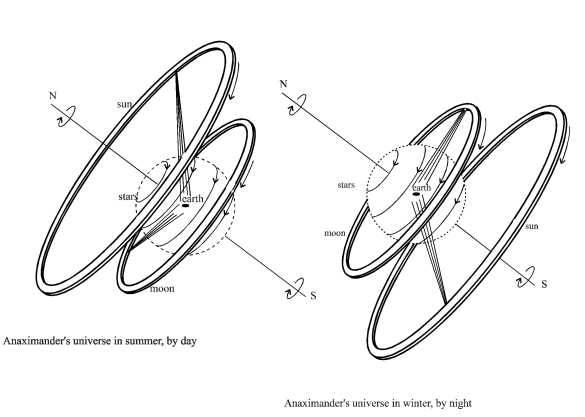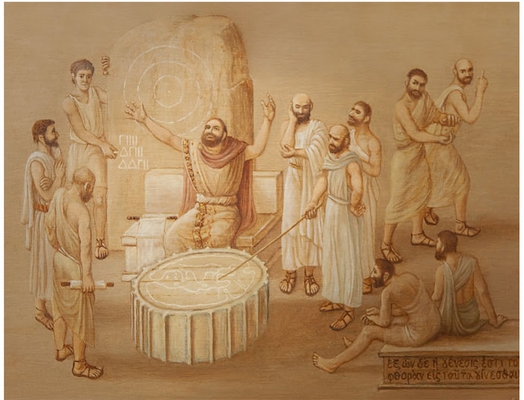Quite regularly the conversation of the Kosmos community returns to the subjects of astronomy and geography. In this post I will attempt to summarize what has been discussed, while focusing on the work of Anaximander, my favorite physiologos.
His approach of understanding the world through rationalization and argumented dialogue [logos] was the logical next step after the period of oral tradition. No less than the messenger of the gods, Hermes, opened the door for him, by showing how impersonal nature [physis] made the magic herb Moly work as antidote against the spells of Circe. This Greek naturalist philosopher (610–546 BCE) was the first next to enter the house of physics. He was a native of Miletos, son of Praxiades, pupil and successor of Thales and the first recognized European scientist (physiologos).
Anaximander extended the concept of the impersonal nature: he modeled physis (nature, the lived world) and peri-physēos (astronomy, geography and history), both being, within the terms of his philosophy, essentially the same. He wrote the lost works “On Nature” (Peri Physeōs), “Circuit of the Earth” (Gēs Periodous), and “On the Fixed Stars” (Peri Tōn Aplanōn) and a Celestial Globe (Sphairan “sphere”). In these works, of which only one fragment survives, he describes his principle in terms of respectively the origin of all things (archê), proto-geography, proto-astronomy and proto-chronometry[1].
His work Gēs Periodous describes the earth surface and is often referred to as the first Greek map of the inhabited world (oikoumenȇ). On this “map,” which was inscribed on the top of a slightly rounded tablet (pinax, πίναξ), Anaximander proposed an outline (perimetron) of earth and sea. The Aegean Sea was near the map’s center and enclosed by three continents, located in the middle of the ocean and isolated like islands by sea and rivers. The center, or “navel,” of the world (omphalós gēs) must have been Delphi.
In passages relating to Anaximander in the Doxographists, we read: “The earth is a heavenly body, controlled by no other power, and keeping its position because it is the same distance from all things; it has two faces, one of these is the ground beneath our feet, and the other is opposite to it”.[2] and “He (Anaximander) says that the form [schemā] of the earth is curved [guron: “like a hook, or with hunched shoulders”], rounded [stroggulon], round like a stone column [kionos lithos], and that its depth is one-third of its breadth”[3]. Anaximander held that “the earth, which is of spherical shape, lies in the midst, occupying the place of a centre; that the moon, shining with borrowed light, derives its illumination from the sun; further, that the sun is as large as the earth and consists of the purest fire”[4].
According to Diogenes Laërtius, Anaximander made a celestial globe [sphairan] and showed the solstices and the equinoxes by use of a gnomon, originally a Babylonian instrument, which he placed on the sun-dials of Lacedaemon. A modern interpretation of the Anaximandrian Celestial Globe [sphairan] is shown in the image below: (D.L. Couprie, IEoP)

Figure 1: Anaximander’s universe. Drawing by Dirk Couprie
Sixty years after Anaximander, Philolaus the Pythagorean (~480–405 BCE) describes the “perfect configuration” of the cosmos, in which the followers of Pythagoras (~572–500 BCE) believed: a system with stars, planets, Sun, Moon, Earth, and a counter-earth [Antichthon] —ten bodies in all—circling an unseen central fire.[5] In the same period (440 BCE) Herodotus, the most authoritative Greek historian and author of The Histories, makes the following encouraging observation: “I laugh to see how many have before now drawn maps of the world [Gēs periodous], not one of them reasonably; for they draw the world as round as if fashioned by compasses [eousan kukloterea hōs apou tornou], encircled by the Ocean river, and Asia and Europe of a like extent.”[6]
Plato’s Timaeus (360 BCE) was of the opinion that the demiurge created the world in the geometric form of a globe: “…the fitting shape will be that which comprises within itself all the shapes there are; wherefore He wrought it into a round, in the shape of a sphere, equidistant in all directions from the center to the extremities, which of all shapes is the most perfect and the most self-similar….”.[7] Aristotle (384–322 BCE) took a practical approach in describing the cosmology and based his conclusions on observations: he agreed that the earth is spherical, because “otherwise not every moon eclipse would show an intersection in the form that we see it.”[8] Referring to the Pythagoreans Aristotle said that “the earth is one of the stars, and moving in a circle about the centre it produces night and day.”[9]
Our conversations on the above subjects continued until we reached the period of Strabo, Pliny and Ptolemy. Underlying was always the feeling of awe and admiration for these early scientists.
For discussion I would pose that oral tradition provided a way of understanding the world through mūthos, and scientists perfected this road with “argumented dialogue.” How do you look at this sequence? Is the first step a necessary condition for the next? Was all understanding transferred and perfected this way? Did we move this “deeper understanding of the world” from a wide community to a small group of elite intellectuals? What happened? I look forward to hearing your opinions on all of the above.

Figure 2: Artist impression of Anaximander teaching his cosmological conception. Drawing by Hans Exterkate
Notes
[1] I.K. McEwen, 1979
[2] Hippolyti philosophumena 6 (Doxographi Graeci 559)
[3] Pseudo-Plutarch Stromata 2 (Doxographi Graeci 579)
[4] Diogenes Laertius Lives of Eminent Philosophers 2.1, R.D. Hicks
[5] Stobaeus, i. 22. 1d, quoted on Wikipedia, translator not named
[6] Herodotus The Histories 4. 36.2, translated by A.D. Godley
[7] Plato Timaeus 33b, translated by W.R.M. Lamb.
[8] Aristotle On the Heavens 2.11, translated by J.L. Stocks
[9] Aristotle On the Heavens 2.13, translated by J.L. Stocks
References
Couprie, Dirk L. 2011. Heaven and Earth in Ancient Greek Cosmology: From Thales to Heraclides Ponticus. Springer New York-Dordrecht-Heidelberg-London.
Diels, 1879. Doxographi Graeci, Berlin, cited in Fairbanks, Arthur. 1898. “Anaximander (Anaximandros): Fragments and Commentary“, The First Philosophers of Greece. London.
McEwen, Indra Kagis. 1997. “Socrates’ Ancestor: An Essay on Architectural Beginnings“. Massachusetts Institute of Technology. Cambridge, MA.
Acknowledgement
Images shown by courtesy of Dirk L. Couprie and Hans Exterkate
Biography
Rien is a regular participant of the Kosmos Society.